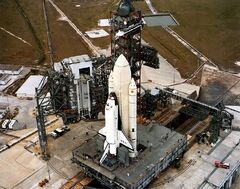The US space shuttle program was the world's first attempt at a manned and reusable orbital vehicle (OV), and was initially authorized by President Richard Nixon in 1969, shortly after the moon landing of Apollo 11. The first 'orbiter', Enterprise, was completed in 1976, but only as an in-atmospheric test craft, and was initially unsuited for space flight, while the first true space capable OV, Columbia, was completed in 1979, and set out on the first shuttle flight, STS-1 on April 12, 1981. The next three orbiters were named, and first flew in -- Challenger in 1983, Discovery in 1984, and Atlantis in 1985. Disaster struck on January 28, 1986, when Challenger disintegrated less than two minutes after liftoff from Kennedy Space Center when one of the SRB rocket boosters' O-ring seals failed and ignited the external fuel tank. As a result of the disaster, NASA made drastic changes to the program, which included refitting Enterprise for spaceflight (on which she first flew in December 1991), and constructing several new orbiters: the first of which, Endeavour, was constructed from structural spares of the first shuttles and first flew in 1992. Three brand-new OVs were constructed by Rockwell International in an offer from NASA: Intrepid, who first flew in 1994, Yorktown, who first flew in 1996, and Constellation, the final orbiter of this design, and made its maiden flight in 1998. The program continued uninterrupted until February 2003, when Columbia unexpectedly disintegrated upon reentry over eastern Texas, killing all seven crew members, and temporarily halting the space program. The loss of Columbia was later determined to be a combination of two factors: 1) The collision of a chunk of external tank foam with the shuttle's thermal tiles at launch, and 2) collision of several small meteorites in orbit while over the Pacific. Directly resulting from this fresh shuttle disaster and the Great Bombardment (of which the fragments that struck Columbia were later determined to be 'predecessors'), the shuttle program didn't resume until July 2005. The seven remaining orbiters continued their flights for six years until being grounded yet again, not from a new shuttle diaster, but from the 2011 meteor bombardment: this kept them grounded from late August 2011 until mid-March 2012. But by the time the shuttles were ready to fly again, however, the disasters of 2012 were rapidly accelerating, and increasing numbers of hurricanes were endangering Kennedy Space Center and Cape Canaveral, as well as the growing threat of an earthquake or Atlantic tsunami. Resulting yet again from the forces of nature, NASA made a drastic move with its orbiter fleet: all seven would be launched near-simultaneously in the early afternoon hours of September 23, 2012, and dock with the International Space Station and the Chinese Tiangong Space Station. Spending nearly the next four months in space, the shuttles completed their longest simultaneous mission ever, dubbed the 'Never-Ending Mission' or 'Mission 2012' by astronauts and the media, on January 11, 2013, when the last shuttle, Constellation, landed on a temporary runway outside Birmingham, Alabama, at the new location of Kennedy Space Center. The shuttle program was on its last legs by this time, however, and funding could only be kept up until 2015 (2016 at the latest), and as such continued almost normally until the final shuttle flight, STS-203, was flown by Atlantis in mid-November 2016. The era of NASA's first-generation orbiters had come to an end after 35 years, but would live on in museums across the country for generations, and their active service would be replaced by that of the third generation OV-210 program (X-33 derivative) that ferried astronauts as far as the Moon and back until the first Mars landing with Highlander 4 in 2036, though these Moon-ferrying trips were made redundant after the lunar landing of Orion 15 in February 2027.
Advertisement
286
pages
Space Shuttle program (US)
Advertisement
